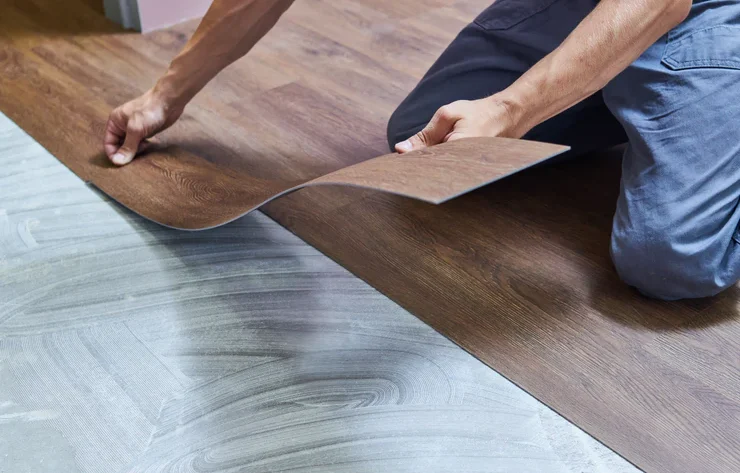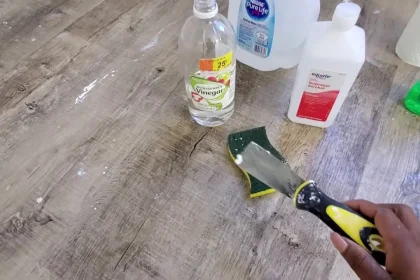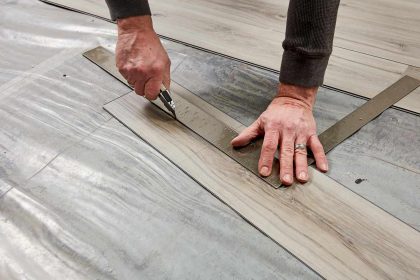Vinyl flooring has become a go-to choice for homeowners who want stylish, low-maintenance floors without the hassle of major renovations. But if your home already has ceramic or porcelain tile, you might wonder: Can you put vinyl flooring over tile? The good news is yes, in many cases, you can install vinyl flooring directly over existing tile. But there are a few important factors to consider before jumping in.
This guide will walk you through everything you need to know, from the pros and cons to preparation tips and installation methods. Whether you’re looking at vinyl plank flooring over ceramic tile or thinking about luxury vinyl tile installation, this complete guide has you covered.
Why Consider Vinyl Flooring Over Tile?
Many homeowners choose vinyl flooring over existing tile because it’s cost-effective and easier than tearing out old floors. Vinyl is known for being durable, water-resistant, and available in many designs that mimic wood, stone, or tile.
Choosing to install vinyl over tile can save you time and money on labor and debris removal. Plus, vinyl’s floating design makes it easy to lay over flat surfaces with minimal prep work.
According to the National Association of Home Builders, vinyl flooring is one of the most popular choices for remodeling projects because of its affordability and ease of maintenance.
Pros and Cons of Installing Vinyl Over Tile
While laying vinyl plank flooring over ceramic tile is often possible, there are both advantages and challenges to keep in mind.
✅ Pros:
- No demolition required: Saves time and reduces mess.
- Quick installation: Floating vinyl systems are designed for fast DIY setups.
- Cost-effective: Reduces labor costs since you avoid tile removal.
- Water-resistant: Perfect for kitchens, bathrooms, and basements.
- Stylish options: Wide variety of colors, patterns, and textures available.
❌ Cons:
- Floor height increase: Adding vinyl over tile can raise the floor height, potentially affecting door clearance and transitions to other rooms.
- Uneven tile surfaces: Deep grout lines or uneven tiles can cause problems if not addressed properly.
- Sound issues: Without proper underlayment, your vinyl flooring may feel hollow or sound noisy when walked on.
Can You Lay Vinyl Over Tile? Key Considerations
The success of installing vinyl flooring on tile depends on the condition of the existing floor. Before moving forward, assess these factors:
- Tile Flatness: Make sure the tile surface is flat without raised edges. If tiles are uneven, you may need to use a leveling compound.
- Grout Depth: Deep grout lines should be filled to create a smooth surface for the vinyl to sit properly.
- Moisture Check: Even though vinyl is water-resistant, the subfloor underneath should be dry and stable to prevent long-term issues.
As flooring expert Tom Kraeutler from The Money Pit podcast advises, “The condition of your existing floor plays a huge role in whether vinyl can be installed successfully over tile. Level, clean, and dry surfaces are non-negotiable” (The Money Pit).
Best Vinyl Flooring for Tile Overlay
When selecting the best vinyl flooring for tile overlay, consider these options:
- Luxury Vinyl Plank (LVP): Mimics hardwood floors and is thicker, providing better sound insulation.
- Luxury Vinyl Tile (LVT): Looks like stone or ceramic tile and works well in wet areas like bathrooms.
- Sheet Vinyl: Best for large, seamless installations but may require more skill to install correctly.
Opting for floating vinyl flooring over tile is typically easier since these products “click” together without adhesives, making DIY installation more manageable.
Preparing Tile for Vinyl Flooring
Proper prep work is crucial for a smooth, long-lasting result. Here’s how to prepare tile for vinyl flooring:
- Clean the Tiles: Remove all dirt, grease, and dust.
- Check for Loose Tiles: Repair or replace any broken or loose tiles.
- Fill Grout Lines: Use a leveling compound to fill deep grout lines.
- Sand Uneven Areas: Sand down high spots to create a flat surface.
- Apply Primer (if required): Some vinyl types recommend a primer for better adhesion.
Failing to prep the tile surface properly can lead to problems like uneven flooring, gaps, or damage down the line.
Methods for Installing Vinyl Flooring Over Tile
There are different ways to approach vinyl flooring installation over tile, depending on the type of vinyl you choose.
1. Floating Installation (Most Common)
- No adhesive required.
- Uses a click-lock system for easy assembly.
- Suitable for DIY vinyl flooring over tile projects.
2. Glue-Down Installation
- Adhesive is applied directly to the tile.
- Works well for vinyl flooring over tile waterproofing areas like bathrooms or laundry rooms.
3. Loose Lay Vinyl
- Heavier planks that stay in place without glue or clicks.
- Often used in commercial spaces.
For most homeowners, floating vinyl flooring over tile is the easiest and most popular choice because of its simplicity and flexibility.
Do You Need Underlayment for Vinyl Over Tile?
Adding underlayment under your vinyl flooring can improve comfort, reduce sound, and help with minor leveling. While many luxury vinyl products come with attached underlayment, in some cases, adding a separate layer may be recommended.
Underlayment is especially useful if your existing tile has slight unevenness or you want extra insulation and cushioning. Be sure to check the flooring manufacturer’s guidelines.
Vinyl Flooring Over Tile Thickness and Transition
One important detail many people overlook is floor height. Adding vinyl on top of tile can increase the height by 5mm to 8mm (sometimes more if underlayment is included). This can affect:
- Door clearance.
- Baseboards and trim.
- Transitions to other flooring types like carpet or hardwood.
Using vinyl flooring over tile transition strips can help create smooth transitions between rooms.
Cost of Installing Vinyl Flooring Over Tile
The vinyl flooring over tile cost in the United States can vary depending on the type of vinyl you select, the condition of the existing tile, and whether you choose to install it yourself or hire a professional.
- Material Costs in the U.S.:
- Luxury Vinyl Plank (LVP): $2.50–$5.00 per sq. ft.
- Luxury Vinyl Tile (LVT): $2.00–$4.50 per sq. ft.
- Sheet Vinyl: $1.00–$3.00 per sq. ft.
- Professional Installation Costs (U.S.):
- Labor typically ranges from $1.50 to $3.50 per sq. ft., depending on your location and the complexity of the project.
If you go the DIY route, you can save significantly on labor costs, paying only for materials and necessary tools like spacers, cutters, or leveling compound. You can even follow a step-by-step method like this vinyl flooring installation guide to get started with confidence.
Skipping tile removal and choosing vinyl flooring over existing tile helps cut down on demolition expenses, making it a budget-friendly flooring upgrade for many U.S. homeowners.
Maintenance and Durability
One of the big perks of vinyl is that it’s easy to maintain. To keep your vinyl flooring over tile looking great:
- Sweep or vacuum regularly.
- Mop with a damp cloth using mild cleaners.
- Avoid abrasive scrubbers that may damage the surface.
High-quality vinyl flooring over tile durability ensures that with proper care, your floors can last 10 to 20 years.
Common Questions About Vinyl Over Tile Installation
Does vinyl flooring stick well to tile?
It depends on the adhesive type and tile surface. Floating vinyl does not require adhesive, while glue-down vinyl may need extra prep for strong bonding.
Can you install vinyl over uneven tiles?
Yes, but the surface must be leveled first using self-leveling compound or underlayment to avoid gaps and instability.
Is vinyl flooring over tile waterproof?
Most luxury vinyl options are water-resistant, and some are fully waterproof. However, ensure grout lines are sealed and the subfloor is dry to prevent hidden moisture issues.
Conclusion
So, can you put vinyl flooring over tile? Absolutely—but success depends on good prep work and choosing the right vinyl product for your space. Whether you go for luxury vinyl plank, floating vinyl flooring, or glue-down vinyl, making sure the surface is clean, level, and dry is the key to a long-lasting installation.
If you’re considering this upgrade for your home, remember to factor in the vinyl flooring over tile cost, thickness, and underlayment needs. And most importantly, always follow manufacturer instructions to avoid issues down the road.
By following this guide, you can enjoy a beautiful, durable new floor without the headache of removing your old tile.





